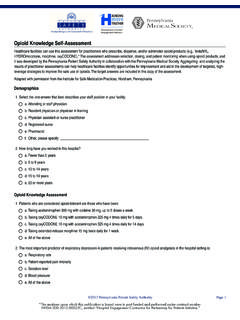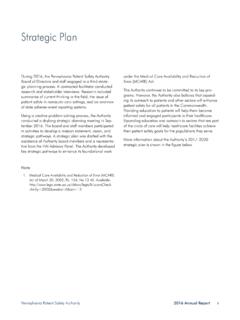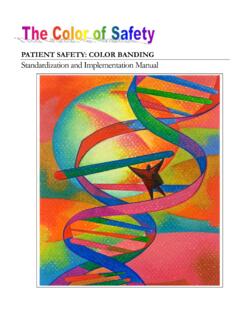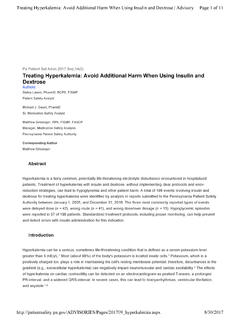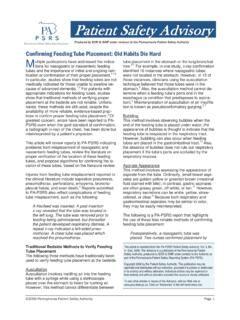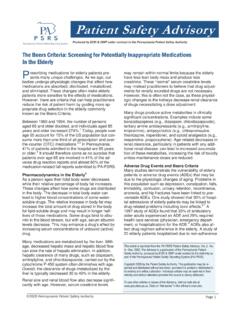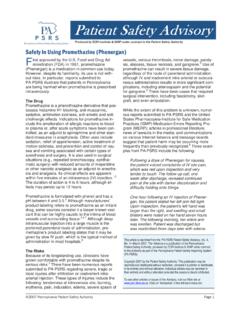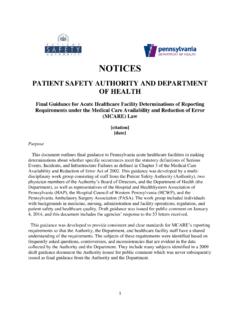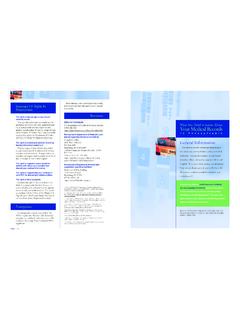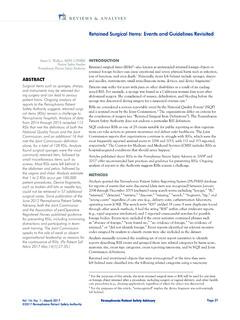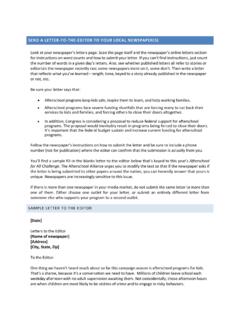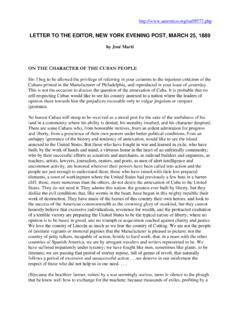Transcription of Letter to the Editor: Preventing Air Embolism with PICC ...
1 Pennsylvania Patient Safety AdvisoryPage 48 OTHER FEATURESVol. 12, No. 1 March 2015 2015 Pennsylvania Patient Safety AuthorityLETTER TO THE editor : Preventing AIR Embolism with PICC LINE REMOVALI read with interest your article Reducing Risk of Air Embolism Associated with Central Venous Access Devices in the Pennsyl-vania Patient Safety Advisory, June 2012. My concern with this document, and many others on the same topic, is that peripher-ally inserted central venous catheters (PICC lines) are lumped in with subclavian and internal jugular central venous catheters and tunneled catheters, when the risk of air Embolism on removal is not at all the the 40 years since PICC lines have been in use, I cannot find a single report in the literature of an occurrence of air Embolism following removal of a PICC line.
2 If you have any instances of this occurring, I would be grateful if you could share this with me and encourage those involved to document these cases in the literature as evidence of the work in a Hospital in the Home service, providing home infusion therapy, where PICCs are removed on the patient s last day on the program. The dressing is not changed daily after removal, and the patient does not have to be observed for 30 minutes post removal. Patients are not put in the supine position for PICC am finding it hard to justify implementing your would be interested in your feedback on this Dobson Clinical Nurse Consultant, Immunology & Infectious Diseases Unit John Hunter Hospital, New Lambton Heights, AustraliaEditor s NoteThank you for your inquiry regarding the risks for air Embolism and the steps recommended to prevent air Embolism occur-rence with PICC line removal.
3 In response, Pennsylvania Patient Safety Authority analysts performed an additional review of the literature and an updated analysis of events reported to the Pennsylvania Patient Safety Reporting System (PA-PSRS) from June 2004 through December 2014. No reports of air Embolism occurring with PICC line removal were found in the literature, nor were any such events reported through PA-PSRS. PICC lines are classified as central venous access devices (CVADs) because their tip lies within a central vein, usually the superior vena cava, where venous pressure is usually lower than atmospheric pressure. This pressure gradient favors the ingress of air. However, the insertion/exit site for a PICC line is in a peripheral vein, where venous pressure is usually higher than atmospheric pressure.
4 This pressure gradient favors the outflow of venous blood and not the ingress of air. If all precautions are taken to maintain a closed system during PICC line removal ( , all lumens capped and/or clamped), the potential for air ingress is minimal. Therefore, the CVAD-associated air embo-lism prevention methods outlined in the Advisory article would apply to PICC line insertion, care, and maintenance but would not apply to PICC line removal. The Authority thanks you for calling this to our attention and providing us the opportunity to make this clarification. Authority analysts sought additional input from Bruce Hansel, ECRI Institute, because of his extensive experience investigating catheter-related problems, including air Reviewer CommentAir Embolism is diagnosed based on manifested signs and symp-toms.
5 Air Embolism may occur with PICC line removal, but the amount of air may be so minimal that it does not produce symp-toms. The absence of symptoms is not sufficient to ensure that no air has entered the vessel. However, this discussion centers on symptomatic Embolism . Because a PICC line is a central venous catheter, it carries with it the same risk of air Embolism while it is in place as other CVADs. However, because it is peripherally inserted, it presents negligible risk of symptomatic air Embolism during removal. In that regard, the precautions suggested in the Advisory article and recommended in the literature for removing CVADs are unwarranted for PICCs for two reasons: (1) the pressure gradient favoring air ingress is much lower at a peripheral site than at a more centrally located CVAD insertion site, and (2) the diameter of a PICC track through the tissue is smaller than that of most CVADs.
6 Furthermore, when removing a peripheral catheter, supine or Trendelenburg is less favorable pressure-wise than a more favorable seated position with the arm at waist level. To prevent air ingress when removing a peripheral intravenous catheter, the exit site needs to be lower than the heart. The same measures used for removing short peripheral intravenous cath-eters should be applied to PICCs. However, a PICC site may be more likely to bleed after removal because it will have a larger and more mature track through the tissues than a short periph-eral intravenous C. Hansel, PhD, CCE Executive Director, Accident and Forensic Investigation ECRI InstituteThis article is reprinted from the Pennsylvania Patient Safety Advisory, Vol. 12, No. 1 March 2015. The Advisory is a publication of the Pennsylvania Patient Safety Authority, produced by ECRI Institute and ISMP under contract to the Authority.
7 Copyright 2015 by the Pennsylvania Patient Safety Authority. This publication may be reprinted and distributed without restriction, provided it is printed or distributed in its entirety and without alteration. Individual articles may be reprinted in their entirety and without alteration provided the source is clearly publication is disseminated via e-mail. To subscribe, go to see other articles or issues of the Advisory, visit our website at Click on Patient Safety Advisories in the left-hand menu Independent Agency of the Commonwealth of PennsylvaniaThe Pennsylvania Patient Safety Authority is an independent state agency created by Act 13 of 2002, the Medical Care Availability and Reduction of Error (Mcare) Act. Consistent with Act 13, ECRI Institute, as contractor for the Authority, is issuing this publication to advise medical facilities of immediate changes that can be instituted to reduce Serious Events and Incidents.
8 For more information about the Pennsylvania Patient Safety Authority, see the Authority s website at Institute, a nonprofit organization, dedicates itself to bringing the discipline of applied scientific research in healthcare to uncover the best approaches to improving patient care. As pioneers in this science for more than 40 years, ECRI Institute marries experience and indepen-dence with the objectivity of evidence-based research. More than 5,000 healthcare organizations worldwide rely on ECRI Institute s expertise in patient safety improvement, risk and quality management, and healthcare processes, devices, procedures and drug technology. The Institute for Safe Medication Practices (ISMP) is an independent, nonprofit organization dedicated solely to medication error prevention and safe medication use.
9 ISMP provides recommendations for the safe use of medications to the healthcare community including healthcare professionals, government agencies, accrediting organizations, and consumers. ISMP s efforts are built on a nonpunitive approach and systems-based SAFETY ADVISORYScan this code with your mobile device s QR reader to subscribe to receive the Advisory for PENNSYLVANIA PATIENT SAFETY AUTHORITY AND ITS CONTRACTORS
